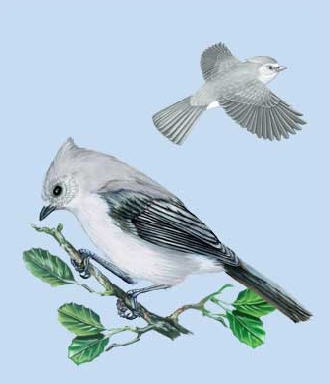|

Small
titmouse with gray upperparts, paler underparts, and plain gray,
crested head. Tail is long and dark.
Along with the Oak Titmouse,
was known as the Plain Titmouse
until 1996, when they were shown
to be seperate species due to
differences in song, habitat,
and genetic makeup.

|
JUNIPER
TITMOUSE
Baeolophus ridgwayi
PASSERIFORMES
Titmice and Chickadees (Paridae)
Range and Habitat
Resident in western and southwest U.S. Pinyon-juniper woods are favored
habitat.
SOUND: "tschick-adee"
The American Ornithologists' Union split the Plain Titmouse into the
Oak Titmouse and the Juniper Titmouse in 1996, due to distinct differences
in song, preferred habitat,
and genetic makeup.
Strong legs and feet allows it to hang upside down to forage.
The incubating female sits very tight on the nest while incubating,
and will hiss like a snake if disturbed.
A group of titmice are collectively known as a
"banditry" and a "dissimulation" of titmice.
The Juniper Titmouse has a current rating of Least Concern due to the
stability of its population and range. The Juniper Titmouse is native
to only one country, Mexico. The range of the Juniper Titmouse is about
1 million kilometers. The population of the Juniper Titmouse is about
300,000 individual birds. The prior rating for this bird species was
Lower Risk. That rating was downgraded to Least Concern in 2004.
At this time there are no known risks or threats regarding the range
or the population of the Juniper Titmouse.
|

